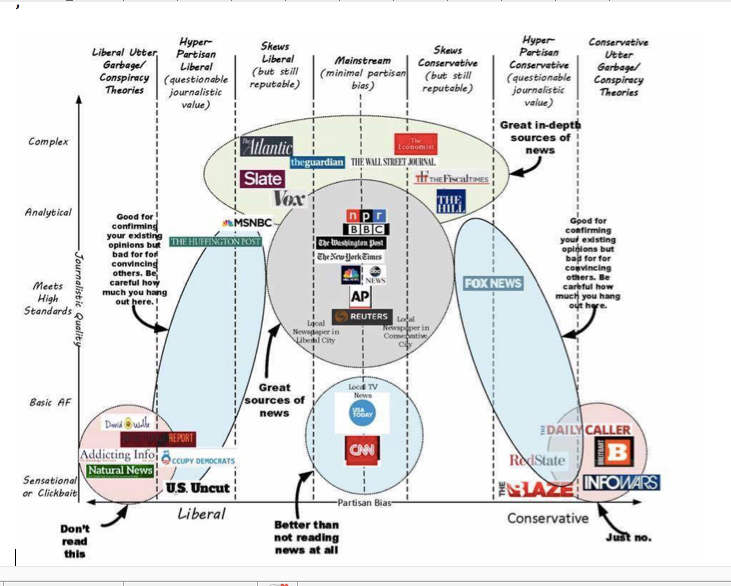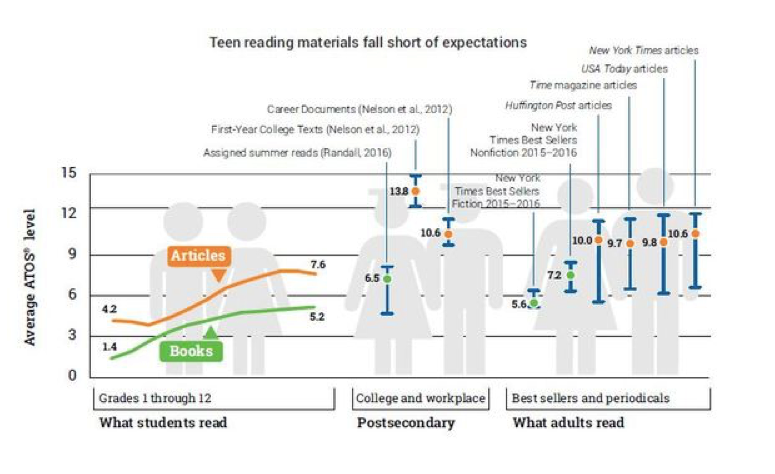THE FREE PRESS AND MEDIA – WHERE TO START?
What difference does it make to all of us if we don’t have a free press? A functioning democracy needs a free press, one that is accessible to all and can be relied on to embrace facts. Without this foundation, we cannot find common ground to solve problems, resolve our differences and remain a strong, viable democracy. We, the people . . .
The first step is to agree on the source of facts and then move on to interpretation and opinion.
FRAMEWORK FOR MEDIA USED ON THIS WEBSITE
We have to get back to the place where we can trust and respect the media and appreciate the role of an independent press. The first step is to identify and define what we mean by media, beginning with the traditional written press and the most powerful and well known members of the TV and radio media.
The framework of the press is in this recently-developed diagram of the best known, and most read media. The infographic, depicting the relationships between various news media, was created after the 2016 presidential election ended. It is beginning of developing a way to make sense of the truly unprecedented assault on facts, news media, accepted tradition or norms of civility. Much of what we believed to be conventions about respect in communication, common courtesy, dignity, integrity are now ignored. Respect for facts, truth, how much dissembling or lying was acceptable from politicians has been thoroughly trampled, demeaned and discarded over the last year.

We literally now have people talking about alternative facts, a president who says what he “believes” is fact and shows significant disregard for verifiable facts. Disregard for the impact of his words, and the effect it has on our country’s standing on the world stage are all current hallmarks. Spokespeople say that he says what he believes and that is why he got elected, to speak his mind. This is a perspective of many American but not all Americans. A majority of voting Americans, 65 million, did not vote for they type of “speaking his mind” and likely do not approve of the ongoing degradation of facts in political discourse.
As we navigate these new and strange waters of deliberate propaganda and misinformation, this infographic below provides a simple framework that clearly shows the relationships among the various news media. Along one side of the graph, the media is rated from sensational or “clickbait” to complex. Along the bottom of the graph, the media is rated from “don’t read this” on the left to “just no” on the right.
In order to develop well-reasoned unbiased opinions, it is essential that we read. Complex analyses are overwhelmingly found in print media. By reading and drawing our own conclusions from print, we avoid the strong influence and bias that we hear on the radio/TV and can see on TV. Most newspapers and magazines have changed their formats to be more readable, shorter and more summarized. As noted in the graph below, most of the articles referenced here will be in the 7th to 10th grade reading level.

Almost every article on this website is from one of the sources on this graph is from category 1 or 2 and are considered to be squarely in what we call the fourth estate or mainstream media (MSM). Category 3 and 4 are in a gray area of being in the fourth estate but with blogging/opinion/fifth estate characteristics. The sources in Category 5 and 6 are incredibly biased and are not to be believed. Some of these sources actively spread misinformation and propaganda. There are of course, many, many, many other news sites and outlets. The goal is to use good judgment in evaluating what is read.
- CATEGORY 1 – Great in depth sources of news (7) – The Guardian, The Economist, Vox, Slate, The Atlantic, The Wall Street Journal and The Fiscal Times.
- CATEGORY 2 – Great sources of news (8) — NPR, BBC, The New York Times, Washington Post, ABC, NBC, Associated Press, Reuters
- CATEGORY 3 – Better than not reading at all (2) – CNN and USA Today
- CATEGORY 4 – Good for confirming your existing opinion but bad for convincing others. Be careful how much you hang out here.
- Liberal (2) – MSNBC, The Huffington Post
- Conservative (1) – Fox News
- CATEGORY 5 – Don’t read this — Liberal (6) Occupy Democrat, US Uncut, Natural News, Addicting Info, David Wolfe and Jezebel
- CATEGORY 6 – Just no — Conservative or alt right (5) – Breitbart, Infowars, Daily Caller, Red State, The Blaze
WHAT WE READ TO GET OUR NEWS
There is tremendous interest in trying to figure out this new media environment and to understand how news and fake news are communicated to us. Below are the results of an interesting analysis done to identify what liberal read and what conservatives read. It is an attempt to analyze the supply and demand of news. The results indicate that most news items are covered by all media. However, left leaning readers tend to get their news from one set of sources and right leaning readers tend to get their news from a completely different set of sources. No wonder we seem to be living in two separate media universes.
Below are “alignment measurements” of what people who identify as Democrats or Republicans tended to read most often. They do not indicate a measurement of news organizations’ coverage or “slant.” A -1 indicates a strongly liberal readership, and 1 a strongly conservative readership.
|
More liberal readers |
More conservative readers | ||
| USA Today | -0.06 | AOL.com | 0.01 |
| Reuters | -0.09 | The National Journal | 0.02 |
| Politico | -0.13 | Yahoo! News | 0.05 |
| Bloomberg | -0.16 | CNBC | 0.05 |
| ABC News | -0.16 | Forbes | 0.06 |
| The Washington Post | -0.26 | The Hill | 0.17 |
| CNN | -0.27 | The New York Post | 0.25 |
| The Economist | -0.32 | The Wall Street Journal | 0.28 |
| BBC | -0.33 | The Daily Mail | 0.29 |
| The Los Angeles Times | -0.4 | Zero Hedge | 0.47 |
| VICE News | -0.43 | Infowars | 0.6 |
| Buzzfeed | -0.52 | RealClearPolitics | 0.66 |
| The New York Times | -0.55 | The Washington Times | 0.7 |
| The Guardian | -0.57 | Fox News | 0.78 |
| The Huffington Post | -0.62 | The Weekly Standard | 0.91 |
| Vox | -0.66 | Breitbart | 0.91 |
| The New Yorker | -0.76 | Hannity.com | 0.94 |
| Mother Jones | -0.87 | Red State | 0.96 |
| Daily Kos | -0.9 | GlennBeck.com | 0.97 |
| Democracy Now | -0.93 | RushLimbaugh.com | 1.01 |
| The Nation | -0.95 | ||
| Jezebel | -0.95 | ||
Chartbeat quantified “supply” based on the average number of articles published per publisher among organizations with more liberal or conservative readers. It estimated “demand” based on the average “engaged time” devoted to each article across camps. Engaged time – not a measure of pure traffic – is the time in which acts of reader engagement, like scrolling or clicking, occurs on an in-focus web page of an active browser. The sample consists of about 148 publishers from the Chartbeat network; of these, 107 had more liberal readers and 41 had more conservative ones.
A LITTLE HISTORY . . .
A free press is specifically identified in the First Amendment to the Constitution as an essential right to be protected. The press is more than individual freedom of speech, it is essential for democracy to exist, to flourish. The First Amendment reads:
“Congress shall make no law respecting an establishment of religion, or prohibiting the free exercise thereof; or abridging the freedom of speech, or of the press; or the right of the people peaceably to assemble, and to petition the Government for a redress of grievances.”
There is always tension between the press and those they report on. What is new now is that the president has declared that the press is the “opposition party” and indeed is an “enemy of the people.” The idea that our country could reach a point where the president of the United States would make these accusations is nothing short of astonishing. And it is the starkest example of how much our democracy is being threatened from within. Clearly the media is in the center of all of this.
The breadth, depth and scope of the media landscape is profoundly different that is was when the Bill of Rights was written. Clearly our media environment is much more complex that the one Thomas Jefferson was speaking of when he famously said:
“Were it left to me to decide whether we should have a government without newspapers, or newspapers without a government, I should not hesitate a moment to prefer the latter.”
The term “Fourth Estate” most commonly refers to the news media, especially print journalism or “the press”. Thomas Carlyle attributed the origin of the term to Edmund Burke, who used it in a parliamentary debate in 1787 on the opening up of press reporting of the House of Commons of Great Britain. “There are three estates in Parliament but in the Reporters’ Gallery yonder there sits a Fourth Estate more important far than they all. It is not a figure of speech or witty saying, it is a literal fact, very momentous to us in these times.”
In the US, the phrase “fourth estate” is contrasted with the “fourth branch of government“, a term that originated because no direct equivalents to the estates of the realm exist in the United States. The “fourth estate” is used to emphasize the independence of the press, while the “fourth branch” suggests that the press is not independent of the government.
Another “estate” that has grown tremendously in the past few years and made a sea change in what we know as media. The internet and social media have radically altered how we gain access and consume news. The traditional meaning of the Fifth Estate is a socio-cultural reference to groupings of outlier viewpoints in contemporary society, and is most associated with bloggers, journalists publishing in non-mainstream media outlets, and the social media. Much of the alt-right media gained a foothold as fifth estate entities.
We are at the very beginning of this discussion about facts and reliable media sources. Likely we all agree we need facts but do not agree on the source of facts.
